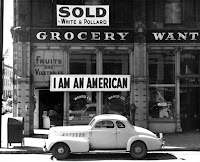Numerous
photos of the experiences of the Japanese-Americans during the post-Pearl
Harbor bombings can be found. The experiences are varied, but have a common
theme: an obvious display of prejudice and racism. While the practice of sending American citizens to internment camps was a dismal policy, these citizens were often forced to sell their businesses, homes, and posessions before being sent away. Why were the
Japanese-Americans on the mainland treated with such scorn while other Japanese
(Hawaii) were left to go about their daily lives? If racism was the chief
factor behind Executive Order 9066, why were certain Japanese-Americans omitted
from this order?
source Location: Boston, MA. Post December 7th reaction on the mainland.
(source) "Los Angeles, California. Last call to
pick up suits and gowns before shades were pulled down in "Little
Tokyo" prior to evacuation of residents of Japanese ancestry. Many were
assigned to Manzanar War Relocation Authority center, in Owens Valley,
California."
(source) Labor shortage caused by indiscriminate internment policy. Hawaii had no such policy implemented, yet had a greater number of Japanese inhabitants than the entire mainland United States.
(source) Labor shortage caused by
indiscriminate internment policy. Hawaii had no such policy implemented, yet
had a greater number of Japanese inhabitants than the entire mainland United
States.
(source) Camps are located away from any major urban area. Was the government wary of espionage or was there a concerted effort to silence this group of American citizens to bolster national morale (and war bond drives)?
Seattle newspaper interviews local farmers (October 1944) and finds widepsread plans to bar the former Japanese-Americans from reclaiming the property and livelihood before Executive Order 9066 was put into place. The Japanese were a thriving part of the West coast economy, so it brings into question why did President Roosevelt allow for the removal of such a vital part of the war effort?
(source)
DBQs.
A) Given
that there were approximately 120,000 Japanese Americans interned at 10
different camps, why did the government choose these locations?
B) According
to the 1940 U. S. census, the Japanese were a large part of the farming
industry. With the war demanding rationing of most goods, why would the
government cut off an important supplier of food sources to the population
(besides racist intentions)?
C) Why did
the government force the Japanese to sell their businesses and homes if the
relocation was intended to be temporary? What do you think the Japanese thought
were the reasons for the implementation of Executive Order 9066?







No comments:
Post a Comment